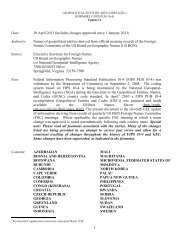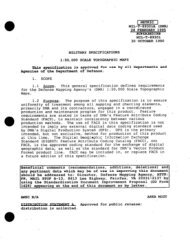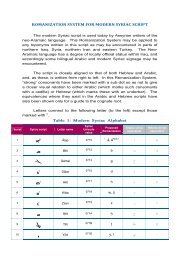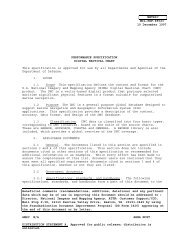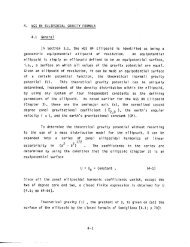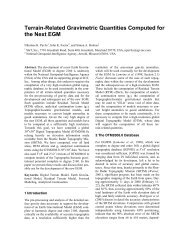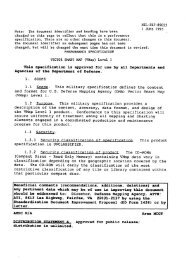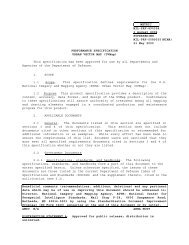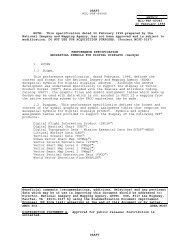1 - NGA
1 - NGA
1 - NGA
Create successful ePaper yourself
Turn your PDF publications into a flip-book with our unique Google optimized e-Paper software.
Ioxodromlc curve-See rtrumb line.<br />
lunar celestiel equator—A great circle on<br />
the celestiaf sphere in the plane of the<br />
Moon’s equator, i.e., in a plane<br />
perpendicular to the Moon’s axis of<br />
rotat ton.<br />
lunar chart-A charl showing the surlace 01<br />
the Moon.<br />
lunar cycla-Any cycle related 10 the Moon,<br />
particularly the Callippic cycle or Ihe<br />
MeIonic cycle. See also saros.<br />
lunar day—The interval between two<br />
successive upper transits of Ihe Moon over<br />
a local meridian. The period of Ihe mean<br />
lunar day, approximately 24.S4 solar hours,<br />
Is derived from the rotation of the Earth on<br />
its SXiS relative to the movement of the<br />
Moon aboul the Earth. Also called tldaf<br />
day.<br />
lunar declination—Angular distance 01 the<br />
Mcen expressed in degrees north or south<br />
of the ceieslial equator; it is indicated as<br />
posllive wnen norm. and negative when<br />
south of lhe equa!or. Also called<br />
declination of the Moon.<br />
lunar dla!ance—The angle between the line<br />
of sight toward Ihe Moon and the line o!<br />
sight toward another celestial bedy at Ihe<br />
point 01 an observer on lhe Earth.<br />
lunar aartfselde than—A chart showing<br />
that portion of lha Moon% surtace visible<br />
from” the Earlh,<br />
lunar ecllpae-The phenomenon observed<br />
when the Moon enlers Ihe shadow of the<br />
Earth. A lunar eclipse is partial if only part ot<br />
ifs surface is obscured; and tolal if the<br />
entire surface is obscured.<br />
lunar equation—A Iaclor used m reduce<br />
observatbms of celestial bodies to the<br />
barycenter of the Earlh-Moon system.<br />
lunar faralde chart-A chart showing that<br />
portion of the Moon’s surface rwt visible<br />
from the Earth.<br />
Iuner Inequellt y—1. Variation in the<br />
Moon’s motion in its orbit, due to attraction<br />
MIL-HDBK-850<br />
149<br />
by other bodies of the solar system. Sae<br />
also evectlon; parlurbatlon. 2. A<br />
rninu!e fluctuation ot a magnetic needle<br />
horn fts maan pcsltiin, caused by Ihe<br />
Moon.<br />
lunar Interval-The dltferance in lime<br />
behveen the transit of tha Moon over the<br />
Greenwich meridian and a local meridian.<br />
The lunar interval equals the diflemnce<br />
between the Greenwich and total intenfala<br />
of a tide or current phase.<br />
lunar month—See aynodlcal month.<br />
Iuna r nods-A node of the Moon’s orbii.<br />
tunar parallax—The horizontal parallax or<br />
the geocentric parallax of the Moon.<br />
lunar aatelllte-A man-made safellite that<br />
makes one or more revolutions about the<br />
Moon.<br />
Iuner tida-Thai part ot the tide caused<br />
solely by the tide-producing forces of the<br />
Moon as distinguished trom that parl<br />
caused by the tortes Of the Sun.<br />
lunar Urns-l. Time based upon the<br />
rotation of Ihe Earth relative to the Moon.<br />
2. Time on the Moon. See also<br />
Greenwich lunar time; local lunar<br />
time.<br />
lunatlon—See aynodlcal month.<br />
I u ne—Thai part ot the sutlace of a sphere<br />
bounded by halves of two great circles.<br />
lunlcentrlc—See ealenocentric.<br />
.Iu nlaolar effect—Gravitational elf acls<br />
caused by lhe a!lraction of fhe Moon and<br />
of the Sun.<br />
Iunlsolar perturbation-Perfurbafions of<br />
artificial satellite orbits due to the attractions<br />
of the Sun and the Moon. Tha mosf<br />
Imporlanl effects are secular variations in<br />
me mean anomaly, in the right ascension<br />
01 the ascanding node, and in the<br />
argument of perigee. All other orbital<br />
elements, except the mapr semiaxis,<br />
undergo long periodic changes.<br />
Iunlsolar preceaalon—lhat component ‘of



